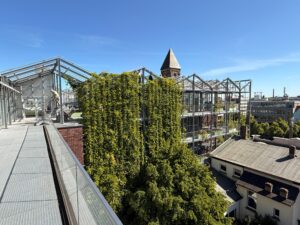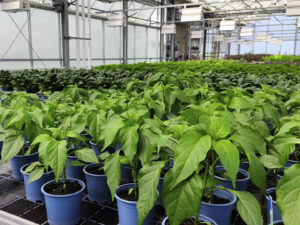Cultivation in or on buildings in urban centres offers a resource-conserving and space-efficient form of agricultural production. The inFARMING® development platform at Fraunhofer UMSICHT has been developing innovative technologies and materials that form the basis for regional and high-quality plant products for 10 years now. The potential is enormous, says Volkmar Keuter, Head of the Environment and Resource Department, looking at what has been achieved so far and the next steps.
Why are modern cultivation techniques becoming increasingly important for agriculture?

©Fraunhofer UMSICHT, Volkmar Keuter, Head of the Department Environment and Resources at Fraunhofer UMSICHT.
Volkmar Keuter: Modern cultivation techniques are often found in protected cultivation methods – such as cultivation in greenhouses or in modern indoor farms, known as controlled environment agriculture (CEA). Here, plants can be produced under ideal, customised conditions. Particularly in light of the heatwave months between 2017 and 2020, during which very heavy irrigation was required, the question arises as to whether cultivation in the open field is still economically viable and sustainable in the long term. The more time-consuming cultivation becomes and yields are jeopardised, the more important modern cultivation techniques become.
Another advantage of protected cultivation in hydroponic or aeroponic systems is that production can ©be carried out without harmful emissions. Take, for example, the nitrate problem in drinking water: this is due to over-fertilisation caused by agriculture. Alternative cultivation methods have the advantage that almost the entire nutrient liquid can be recirculated.
10 years ago, the inFARMING® development platform was launched at Fraunhofer UMSICHT. What is behind the idea?

©Fraunhofer UMSICHT, The ALTMARKTgarten in Oberhausen, Germany
Volkmar Keuter: inFARMING® stands for integrated agriculture. The idea behind it is to utilise existing building and neighbourhood types to cultivate plants on or in buildings. Originally, it was an idea from the USA that came to our attention around 12 years ago. Back then, the company BrightFarms from New York was testing greenhouse installations on high-rise buildings. Since then, we have been working with Simone Krause, Group Manager Urban Transformation, and Holger Wack, Deputy Head of Product Development, to develop the topic further. Our work complements each other perfectly by bringing together engineering developments with business model development and stakeholder-centred design.
The initial question was whether such systems could be transferred to Germany and Europe and how Fraunhofer UMSICHT could act as a technology developer. This was followed by a strategy process in the course of which the inFARMING® development platform was created.
What are the advantages compared to previous cultivation practices?
Volkmar Keuter: inFARMING® focusses on efficient, ideally cycle-based plant production at the point of need. Modern cultivation techniques can be used not only for salads or herbs, but also for plants with a higher added value, such as medicinal and aromatic plants. Cultivation could take place not only in urban areas, but also at the place of processing. Such cultivated foods are also very interesting for consumers in cities, as the products are fresher and of higher quality. It is also possible to cultivate old varieties that are rarely found on supermarket shelves. At the same time, emissions from transport are drastically reduced.
We have already been able to show in the past that even plants that are not expected can be cultivated hydroponically. The yields were even significantly higher compared to field cultivation. In these feasibility studies, we work closely with the plant sciences – e.g. the University of Münster in the field of plant biotechnology or Osnabrück University of Applied Sciences in the field of cultivation system development.
inFARMING® is based on a total of five fields of technology. What are they?

10 years of inFARMING®: view inside the ALTMARKTgarten in Oberhausen, Germany.
Volkmar Keuter: In the five areas, we utilise the opportunities that arise from the synergies between modern plant production and building or neighbourhood infrastructure, among other things. In the area of nutrient production, for example, we can now generate an NPK liquid fertiliser (NPK: nitrogen, phosphorus and potassium) that consists mainly of recyclates. This method has advantages over aquaponic systems because we can keep more nutrients in circulation and can dispense with complex tank constructions for fish farming.
In modern indoor farms, the light required for photosynthesis is usually supplied by LED systems. There are still many scientific questions regarding these lighting systems, particularly with regard to the effects on quality. Under what conditions is growth particularly good? When is the quality best? For example, when is the content of secondary ingredients at its highest? It is expected that LED systems will become even more efficient in the future, thereby reducing the energy costs of indoor farms. However, these can already be reduced today through innovative control options.
In the third area, we are working on new sensory solutions, for example to measure the quality, harvest time or concentration of ingredients in plants in a non-contact and non-destructive manner. We assume that automation solutions will play an even greater role in plant cultivation in the future.
In the fourth field of development, materials for modern cultivation methods, we are researching new cover systems and functionalised materials. Holger Wack is currently responsible for the Light-Light-Roof project, in which a weight-optimised glass-foil module system is being developed as a roofing material together with an industrial partner.
In the fifth development field, we are currently focussing systemically on the topic of energy cycles. Thanks to the ALTMARKTgarten in Oberhausen, we have a unique real-life laboratory on our doorstep where we can test and evaluate new systems.
Speaking of ALTMARKTgarten: What are the biggest milestones in your research work in this area so far?
Volkmar Keuter: Three milestones are very close to my heart. As part of the SUSKULT project, we have succeeded in generating an NPK liquid fertiliser with which we can cultivate vegetables hydroponically with the same yields as with purely mineral fertilisers. Initial results indicate that we have no inherent risks to fear. We will continue to evaluate the process over the next two years as part of a pilot programme.
The ALTMARKTgarten in Oberhausen, where various technological developments were brought together in a real laboratory for the first time under the project management of Simone Krause, has attracted a great deal of attention. Plants are cultivated in different climate zones over an area of 1000 square metres. The ALTMARKTgarten is a flagship project for urban development and for the entire topic of urban agriculture in Germany. There is great interest in our expertise in this area and we have already received enquiries from other cities. An initial feasibility study for the city of Düsseldorf has already been completed.
The third milestone is certainly the non-destructive measurement method. We made significant progress in this area last year, so that in future the time of harvest will no longer be determined by the size of a head of lettuce, but by its vitamin content.
Your research activities are focussed on Germany. What is the situation internationally?
Volkmar Keuter: The potential of indoor farms outside of Germany is currently much greater and is being utilised more in Asia in particular. Japan is certainly leading the way. An indoor farm in Kyoto, for example, produces a good 21,000 heads of lettuce a day on an area of around 4,000 square metres. Germany and Europe still play a rather small role in this area internationally. We want to change that.
Will conventional agriculture then become less important in certain regions?
Volkmar Keuter: You have to differentiate between inFARMING® as a complete solution and the individual technology modules. The modules in particular can be interesting for existing horticultural production and can be integrated into it. inFARMING® as an overall concept for plant cultivation at the point of need can have an influence on traditional agriculture. However, I don’t see it as competition or rivalry, but as a useful addition. Interest in innovative cultivation systems is growing, especially among young farmers who are thinking about new business models and approaches and are focussing on modern technologies or concepts.
In the cultivation of medicinal and medical plants, among other things, our industry partners and we are observing that production systems at the place of processing, i.e. in Germany, can make sense due to fluctuating qualities and yields in the countries of origin. Possible supply chain dependencies could be reduced in this way.
What are the next steps for Fraunhofer UMSICHT?
Volkmar Keuter: Several research projects for further development in the development fields have recently started, and more are in the planning stage. The SUSKULT project will run until 2024, and a new five-year funding phase for further topics is in the pipeline. A pilot plant at the Emschermündung sewage treatment plant is due to go into operation in the summer. For the first time, we will be combining the individual technology modules that have been developed in the laboratories at various locations in Germany and Austria in an upscaled manner. The feasibility study in Düsseldorf was also very well received, so that realisation is being discussed.